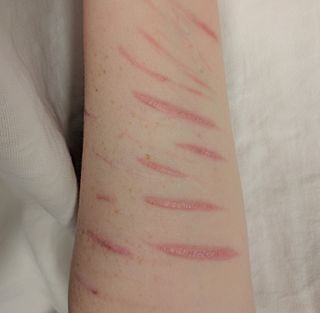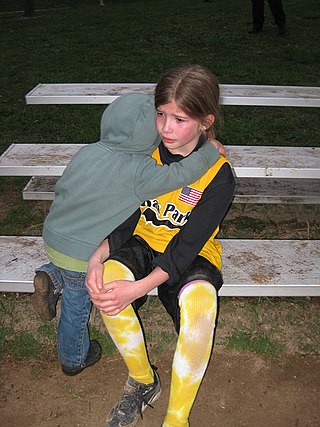Related Research Articles

Self-harm is intentional behavior that is considered harmful to oneself. This is most commonly regarded as direct injury of one's own skin tissues usually without a suicidal intention. Other terms such as cutting, self-injury, and self-mutilation have been used for any self-harming behavior regardless of suicidal intent. Common forms of self-harm include damaging the skin with a sharp object or by scratching, hitting, or burning. The exact bounds of self-harm are imprecise, but generally exclude tissue damage that occurs as an unintended side-effect of eating disorders or substance abuse, as well as societally acceptable body modification such as tattoos and piercings.

The evil eye is a supernatural belief in a curse brought about by a malevolent glare, usually inspired by envy. The belief in the evil eye among humans has existed since prehistory, and amulets to protect against it have been found dating to about 5,000 years ago. It is estimated that around 40% of the world's population believes in the evil eye.
Acculturation is a process of social, psychological, and cultural change that stems from the balancing of two cultures while adapting to the prevailing culture of the society. Acculturation is a process in which an individual adopts, acquires and adjusts to a new cultural environment as a result of being placed into a new culture, or when another culture is brought to someone. Individuals of a differing culture try to incorporate themselves into the new more prevalent culture by participating in aspects of the more prevalent culture, such as their traditions, but still hold onto their original cultural values and traditions. The effects of acculturation can be seen at multiple levels in both the devotee of the prevailing culture and those who are assimilating into the culture.

Compassion is a social feeling that motivates people to go out of their way to relieve the physical, mental, or emotional pains of others and themselves. Compassion is sensitivity to the emotional aspects of the suffering of others. When based on notions such as fairness, justice, and interdependence, it may be considered partially rational in nature.
The culture of the Philippines is characterized by cultural and ethnic diversity. Although the multiple ethnic groups of the Philippine archipelago have only recently established a shared Filipino national identity, their cultures were all shaped by the geography and history of the region, and by centuries of interaction with neighboring cultures, and colonial powers. In more recent times, Filipino culture has also been influenced through its participation in the global community.

In the indigenous religion of the ancient Tagalogs, Bathalà/Maykapál was the transcendent Supreme God, the originator and ruler of the universe. He is commonly known and referred to in the modern era as Bathalà, a term or title which, in earlier times, also applied to lesser beings such as personal tutelary spirits, omen birds, comets, and other heavenly bodies which the early Tagalog people believed predicted events. It was after the arrival of the Spanish missionaries in the Philippines in the 16th century that Bathalà /Maykapál came to be identified with the Christian God, hence its synonymy with Diyós. Over the course of the 19th century, the term Bathala was totally replaced by Panginoón (Lord) and Diyós (God). It was no longer used until it was popularized again by Filipinos who learned from chronicles that the Tagalogs' indigenous God was called Bathalà.

An attachment theory is a psychological, evolutionary, and ethological theory concerning relationships between humans. The most important tenet is that young children need to develop a relationship with at least one primary caregiver for normal social and emotional development. The theory was formulated by psychiatrist and psychoanalyst John Bowlby (1907–1990).
In Philippine folk culture, lihí is a condition of pregnancy food craving. A notable characteristic is that pregnant women usually desire food such as sour, unripe mango with bagoong. While it is a cultural concept restricted among Filipinos, analogous cultural phenomena of pregnancy food cravings have been observed in various cultures. It is still debatable whether lihí can be classified and established as either a biological or psychological condition or a purely social and cultural one.

Filipinos are citizens or people identified with the country of the Philippines. The majority of Filipinos today are predominantly Catholic and come from various Austronesian peoples, all typically speaking Filipino, English, or other Philippine languages. Despite formerly being subject to Spanish colonialism, only around 2-4% of Filipinos are fluent in Spanish. Currently, there are more than 185 ethnolinguistic groups in the Philippines each with its own language, identity, culture, tradition, and history.

Filipino shamans, commonly known as babaylan, were shamans of the various ethnic groups of the pre-colonial Philippine islands. These shamans specialized in communicating, appeasing, or harnessing the spirits of the dead and the spirits of nature. They were almost always women or feminized men. They were believed to have spirit guides, by which they could contact and interact with the spirits and deities and the spirit world. Their primary role were as mediums during pag-anito séance rituals. There were also various subtypes of babaylan specializing in the arts of healing and herbalism, divination, and sorcery.
Mary Dinsmore Ainsworth was an American-Canadian developmental psychologist known for her work in the development of the attachment theory. She designed the strange situation procedure to observe early emotional attachment between a child and their primary caregiver.
Sexual abuse or sex abuse, also referred to as molestation, is abusive sexual behavior by one person upon another. It is often perpetrated using force or by taking advantage of another. Molestation often refers to an instance of sexual assault against a small child, whereas sexual abuse is a term used for a persistent pattern of sexual assaults.
Filipino values are social constructs within Filipino culture which define that which is socially considered to be desirable. The Filipino value system describes "the commonly shared and traditionally established system of values underlying Filipino behavior" within the context of the larger Filipino cultural system. These relate to the unique assemblage of consistent ideologies, moral codes, ethical practices, etiquette and personal and cultural values that are promoted by Filipino society.

Indigenous Philippine shrines and sacred grounds are places regarded as holy within the indigenous Philippine folk religions. These places usually serve as grounds for communication with the spirit world, especially to the deities and ancestral spirits. In some cases, they also function as safeguards for the caskets of ancestors, as well as statues or other objects depicting divine entities.
Minority stress describes high levels of stress faced by members of stigmatized minority groups. It may be caused by a number of factors, including poor social support and low socioeconomic status; well understood causes of minority stress are interpersonal prejudice and discrimination. Indeed, numerous scientific studies have shown that when minority individuals experience a high degree of prejudice, this can cause stress responses that accrue over time, eventually leading to poor mental and physical health. Minority stress theory summarizes these scientific studies to explain how difficult social situations lead to chronic stress and poor health among minority individuals.

The indigenous religious beliefs of the Tagalog people were well documented by Spanish missionaries, mostly in the form of epistolary accounts (relaciones) and entries in various dictionaries compiled by missionary friars.

The COVID-19 pandemic has impacted healthcare workers physically and psychologically. Healthcare workers are more vulnerable to COVID-19 infection than the general population due to frequent contact with infected individuals. Healthcare workers have been required to work under stressful conditions without proper protective equipment, and make difficult decisions involving ethical implications. Health and social systems across the globe are struggling to cope. The situation is especially challenging in humanitarian, fragile and low-income country contexts, where health and social systems are already weak. Services to provide sexual and reproductive health care risk being sidelined, which will lead to higher maternal mortality and morbidity.
The dynamic-maturational model of attachment and adaptation (DMM) is a biopsychosocial model describing the effect attachment relationships can have on human development and functioning. It is especially focused on the effects of relationships between children and parents and between reproductive couples. It developed initially from attachment theory as developed by John Bowlby and Mary Ainsworth, and incorporated many other theories into a comprehensive model of adaptation to life's many dangers. The DMM was initially created by developmental psychologist Patricia McKinsey Crittenden and her colleagues including David DiLalla, Angelika Claussen, Andrea Landini, Steve Farnfield, and Susan Spieker.
References
- ↑ Jocano, F. Landa (1998). Filipino Social Organization: Traditional Kinship and Family Organization. Punlad Research House. p. 78. ISBN 978-971-622-003-2 . Retrieved June 12, 2021.
- ↑ PWE-USOG / PWE-BUYAG: Miscellaneous Therapies in Philippine Alternative Medicine
- ↑ Stoodley, Bartlett H. (1965). Society and Self: A Reader in Social Psychology. Free Press. p. 239. ISBN 978-0-02-931640-5 . Retrieved June 12, 2021.
- ↑ "Postpartum and Philippine Culture - Secondthoughts - Viloria.com". www.viloria.com. Retrieved June 11, 2021.
- ↑ Jocano, F. Landa (1998). Filipino Social Organization: Traditional Kinship and Family Organization. Punlad Research House. pp. 109, 112. ISBN 978-971-622-003-2 . Retrieved June 12, 2021.
- ↑ Fadul, J. Public Forum on Witchcraft and Illnesses. Rizal Technological and Polytechnic Institute, Morong, Rizal. July 24, 1988.
- 1 2 3 100% PINOY (Kapuso Network's cultural program on GMA7 featuring Filipino Culture and Ingenuity to strengthen the Filipino identity.) Aired internationally through GMA Pinoy TV. "Bata, bata, paano ka ginawa?" episode aired August 28, 2008. Pinoy culture, beliefs and practices about "paglilihi, pagbubuntis, panganganak at pag-aalaga sa bata".
- ↑ Cohen S, Janicki-Deverts D, Miller GE (2007). "Psychological stress and disease". JAMA. 298 (14): 1685–7. doi:10.1001/jama.298.14.1685. PMID 17925521. S2CID 12159960. "Stress Contributes To Range Of Chronic Diseases, Review Shows" ScienceDaily.com (October 10, 2007)
- ↑ Tan, Michael (2008). Revisiting Usog, Pasma, Kulam. Quezon City: University of the Philippines Press. p. 178. ISBN 978-971-542-570-4.
- ↑ Youtube Usog
- ↑ http://neurophilosophy.wordpress.com/2006/11/14/lick-your-wounds/ Neurophilosophy: Lick your wounds
- ↑ "Discover Magazine, "The Biology of ...Saliva" October 2005". Archived from the original on February 3, 2007. Retrieved August 22, 2008.
- ↑ Wisner, Anne; Evelyne Dufour; Michaël Messaoudi; Amine Nejdi; Audrey Marcel; Marie-Noelle Ungeheuer; Catherine Rougeot (November 13, 2006). "Human Opiorphin, a natural antinociceptive modulator of opioid-dependent pathways". Proceedings of the National Academy of Sciences . 103 (47): 17979–17984. Bibcode:2006PNAS..10317979W. doi: 10.1073/pnas.0605865103 . PMC 1693858 . PMID 17101991.
- ↑ Andy Coghlan (November 13, 2006). "Natural-born painkiller found in human saliva". New Scientist.
- ↑ "Natural chemical 'beats morphine'". BBC News. November 14, 2006.
- ↑ Mary Beckman (November 13, 2006). "Prolonging Painkillers". ScienceNOW.